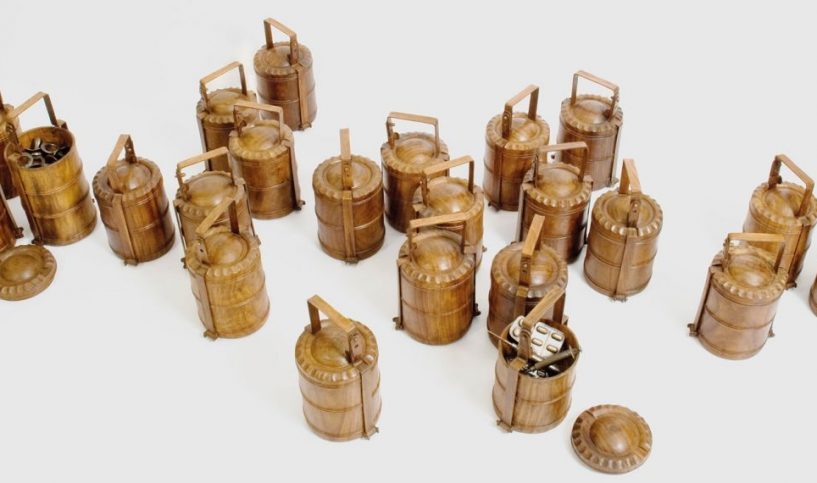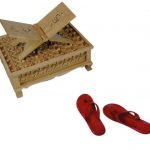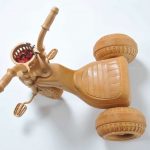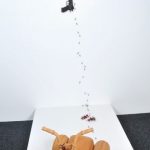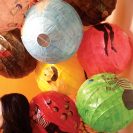Pakistan’s Humaira Abid is recognized as one of the most acclaimed feminist artists. Working primarily in wood, Humaira’s three-dimensional visual storytelling allows her to incorporate social activism within her art.
Over the years, Humaira has deftly developed a signature style by combining sculpture with miniature painting, a style that has garnered the attention of some of the world’s leading art galleries and private collectors and has won many awards and grants.
This award-winning artist’s work touches upon women’s roles, relationships and even taboos, such as domestic violence and miscarriage.
Her work transcends boundaries as she closes the gap between art and life in her sculptural oeuvres. Best known for her “Istri” series, Humaira references belonging, identity, reality and fantasy seamlessly in a new idiom.
Q and A(rt)
For over fifteen years, Humaira has blazed a trail in the world of sculpture and miniature paintings. She graduated with honors from the prestigious art school National College of Arts in Lahore, Pakistan and now divides her time between Pakistan and the US and has studios in both countries.
In an exclusive interview with bazaar, Humaira talks about her art, inspiration and her exciting plans for the future. Read on.
The foremost question in my mind is how do you combine two different disciplines – sculpture and miniature paintings – in your work?
Sculpture, which is bold and three dimensional, is a challenging medium. Miniatures are small in scale, two dimensional, precise, and highly finished. The intensive labor, precision and fine aesthetic values of miniature painting have helped to improve the execution of my sculptures. This penchant for two-mediums has brought a resounding truth to me – all art has a common ethos.
Initially, I practiced sculpture and miniature separately. After a few years of practice and mastering basic techniques, I started experimenting and pushing the boundaries of both mediums. This led me to combine sculpture and miniatures. My early “Istri” series is one example of combining both mediums in a series of work. Today my recent work focuses mainly on this combination.
Your work, diverse in themes, has a constant in the material used – wood. What is the reason for this?
I chose wood as my main medium to bring a woman’s voice and point of view to this male-dominated medium.
In Pakistan, sculpture is generally discouraged by the majority of the people, regardless of the artist’s gender. I pursued a degree in Sculpture as a challenge, since it was considered a tough medium and mostly male-dominated. I wanted to counter the stereotypical image of women as physically and mentally not as strong as men. I choose wood as my main medium and continue to be passionate about it to this day.
What draws you towards particular themes? For instance, how did “Istri” happen?
Being a woman, I cannot escape feelings and things related to women. As my work is about hidden perspectives I try to explore common and everyday objects related to certain activity, duty or part of everyday life. The word ‘Istri’ means a smoothing iron as well as woman/wife in Pakistan and India. Women being my main interest inspired me to this word so I carved out smoothing irons (‘istri’) in wood and made miniatures based on ideas around women (‘istri’) and placed them on the flat side of the carved irons.
You explore sensitive issues, some of which are taboo social issues in some parts of the world. Can you talk in detail about your series titled “RED”?
I developed the “RED” series during and after going through multiple miscarriages. I feel this color has many layers of meaning, interpretations and faces and depicts themes the way I wanted them to be presented.
The color represents love, passion, sacrifice, blood, pain, anger and loss. Basically red symbolizes strong emotion. In the [Indian] subcontinent, red is the traditional color of bridal dresses, and is frequently represented in the media as a symbolic color for married women. The color is associated with love, sexuality and fertility, whereas in some parts of Africa, red is a color of mourning and death. It is often related to the color of blood. This contrast is a major part of my personal life as well as representing the current situation in Pakistan. “RED” is my reaction, my inspiration for this body of work.
I use a lot of symbols in my work. I use everyday objects and present them in unconventional ways. I talk about social issues and stereotypes through my work. I am passionate about discussing taboos like “miscarriage”, which is such a common issue but rarely shared and discussed. I like to initiate conversations around such taboo topics through my work and ‘Breakdown in the Closet’ is one example in which I carved family wardrobe. The concept is conveyed through a stained red baby onesie, which is fallen on the floor; aimed to address this difficult topic in a subtle way.
I’ve had the opportunity to travel and work in many countries and different parts of the world and learned that women’s issues are the same everywhere – it’s just the scale, which is different work from the “RED” series has been displayed in United States as well Pakistan, two completely different cultures and societies. It was interesting to see a similar response in both locations. I am happy that people are showing interest and open to discussing such taboos. I totally believe that a work of art should have a purpose. Art should comfort the disturbed and disturb the comfortable.
The maternal feelings are universal. In your poignant “LULLABY” series, you explore narratives surrounding the ideas of what it is to be a woman and how society views motherhood. Are there issues close to your heart that you are expressing in your body of work?
The “Lullaby” series was mainly to celebrate womanhood/motherhood. There are many things women do which are taken for granted and not appreciated, like doing the chores while raising kids, taking care of house or the family, etc. I want to bring up and present these overlooked issues and roles through my work.
Your work serves as guide for viewers to navigate the often difficult terrain of social and political issues, such as gender, motherhood, and duality in your work. Is this part of your intention as an artist?
Yes it’s the choice I have made and it’s the area I am most interested in. My goal is to raise awareness, bring up issues, which are overlooked and discuss taboos through my work. Whatever people don’t want to talk about, I want to bring it up. This has been the main purpose of my work and will always be.
What do you want to achieve with your art?
I am most passionate about creating works that make you think, that questions important social and political issues. I don’t necessarily need to answer them, but I want to start conversations.
You have come a long way from your first exhibition back in 2001. With the well-deserved success you have already achieved, what’s in the pipeline for you now?
I am currently developing a new body of work. The series will create a surreal world of wood combined with other mediums to convey layers of message, and will enhance the viewer’s experience through unconventional installation.
I have many important exhibitions coming up this year including one at Tacoma Arts Museum, my next solo show at ArtXchange Gallery Seattle in Washington, USA and solo booth representation with Khaas Art Gallery at START Art Fair in London.
In future, I see myself continue to explore themes from women’s lives that are rarely openly acknowledged in the world of fine art.
Images courtesy of the artist Humaira Abid. For more information on the artist, please visit www.humaira.com.pk.

